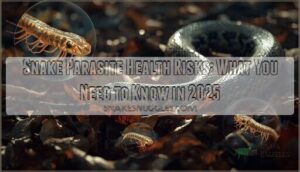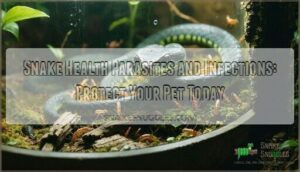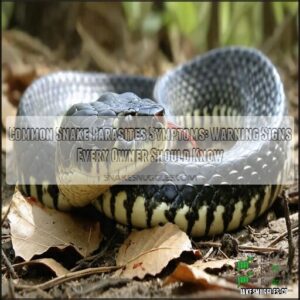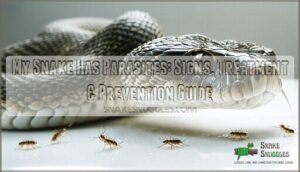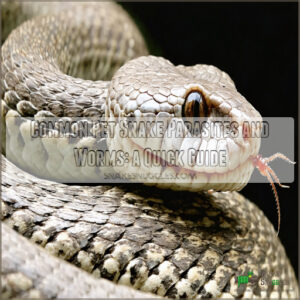This site is supported by our readers. We may earn a commission, at no cost to you, if you purchase through links.
Picture a snake gliding through leaf litter—what you don’t see are the invisible hitchhikers riding along. Parasites like Cryptosporidium and tongue worms don’t just threaten the reptile’s health; they can quietly leap the species barrier, turning a simple encounter into a public health puzzle.
Whether you keep snakes as pets, work with wildlife, or live in regions where snakes are common, understanding snake parasite health risks isn’t optional anymore. With new cases emerging and transmission routes evolving, knowing what’s lurking beneath those scales helps you protect both yourself and the animals you care about.
Table Of Contents
- Key Takeaways
- Common Snake Parasites and Their Types
- Transmission Routes to Humans
- Health Risks and Diseases in Humans
- Recognizing Parasite Infections in Snakes
- Prevention and Risk Reduction Strategies
- Frequently Asked Questions (FAQs)
- Can humans get parasites from snakes?
- What diseases can snakes give you to humans?
- How likely is it to get salmonella from a snake?
- Can snakes make humans sick?
- How long can snake parasites survive outside hosts?
- Can snake parasites spread between different reptile species?
- Are wild snakes more parasitized than captive ones?
- Do certain snake species have natural parasite resistance?
- Can snake parasites affect other household pets?
- How do parasites impact snake behavior and ecology?
- Conclusion
Key Takeaways
- Snake parasites like protozoa, helminths, pentastomids, and ectoparasites pose significant risks to both reptile and human health, with some species reaching prevalence rates over 60% in wild populations.
- Zoonotic transmission can occur through direct contact, environmental contamination, consumption of undercooked snake meat, and bites from ticks or mites, making hygiene and safe handling crucial.
- Vulnerable groups—including children, immunocompromised individuals, and rural communities—face higher risks of severe illness, from gastrointestinal distress to life-threatening complications.
- Regular veterinary screening, public health education, and stricter regulation of reptile trade and meat consumption are vital strategies for reducing parasite-related health threats.
Common Snake Parasites and Their Types
Snakes carry a surprising variety of parasites, and understanding what they are can help you protect yourself and your pets. These organisms range from microscopic single-celled protozoa to visible external parasites that attach to a snake’s skin.
Here’s what you need to know about the four main groups of parasites that commonly affect snakes.
Protozoa (e.g., Giardia, Cryptosporidium)
Among snake parasites, protozoa like Giardia duodenalis and Cryptosporidium parvum pose serious zoonotic transmission risks. Molecular detection revealed infection prevalence rates of 4.15% for Giardia and up to 64.6% for Cryptosporidium in surveyed populations.
Risk factors include older snake age, with clinical impact ranging from asymptomatic carriage to acute gastrointestinal illness in humans exposed through direct contact with infected reptiles.
These protozoa infections highlight the importance of assessing zoonotic risks between animals and humans.
Helminths (Nematodes, Cestodes, Trematodes)
Helminths represent the most prevalent parasitic infections you’ll encounter in snakes, with helminth prevalence reaching 95.65% in wild populations. Nematode infections dominate this group, frequently involving Capillaria and Oxyuris species detected in up to 97% of cases.
Cestode risks increase through consumption of undercooked reptile meat, particularly from Spirometra infections found in 91.30% of wild snakes. Trematode transmission occurs when eggs contaminate aquatic environments, raising zoonotic helminthiasis concerns through water contact and undercooked aquatic food sources.
Snakes can also contract parasites like Spirometra spp. through infected hosts.
Pentastomids (Tongue Worms)
Pentastomids, or tongue worms, present a unique zoonotic risk you can’t ignore. These worm-like parasitic crustaceans infect up to 59% of wild snake populations in tropical regions, with species like Raillietiella orientalis reaching prevalence rates exceeding 40%.
Human pentastomiasis occurs through:
- Consuming undercooked snake meat
- Direct handling of infected reptiles
- Environmental fecal contamination
- Inhalation of airborne larvae
- Contact with contaminated surfaces
Visceral pentastomiasis affects your liver, lungs, and lymph nodes, with detection often requiring radiographic or histopathological diagnostic approaches. Public health strategies emphasize hygiene education and regulated reptile trade to reduce zoonotic transmission from these persistent zoonotic parasites.
Ectoparasites (Ticks, Mites)
While tongue worms lurk internally, ectoparasites work from the outside. Ticks and mites infest 7.69% to 10.7% of surveyed snake populations, with all identified cases involving Mesostigmata mites like Ophionyssus natricis. These parasites aren’t just a snake health concern—they’re vectors for zoonotic pathogens including Aeromonas hydrophila and Borrelia species, raising your risk through mechanical transmission during handling.
| Ectoparasite Type | Common Species | Vector Competence |
|---|---|---|
| Macronyssid Mites | Ophionyssus natricis | Aeromonas, Rickettsia, Leishmania |
| Ixodid Ticks | Ixodes, Amblyomma | Borrelia (2.63% prevalence) |
| Argasid Ticks | Ornithodoros turicata | Borrelia turicatae (relapsing fever) |
| Snake Mites (General) | Mesostigmata order | Gastroenteritis agents, bacterial pathogens |
| Specialized Vectors | Various Macronyssidae | Hemorrhagic disease agents, endosymbionts |
Human infestation remains rare, but mite identification and preventative measures—quarantine protocols, regular screening, environmental sanitation—reduce your exposure to these parasitic infection vectors considerably.
Transmission Routes to Humans
Understanding how snake parasites reach humans is the first step in protecting yourself and your family. You don’t need direct contact with a snake to be at risk—parasites can travel through multiple pathways, some of which might surprise you.
Let’s look at the four main routes these organisms take from reptile hosts to people.
Direct Contact With Snakes or Feces
When you handle snakes or clean their enclosures without proper precautions, you’re exposing yourself to zoonotic parasites and zoonotic disease through direct contact and fecal contamination. Snake feces harbor Giardia, Cryptosporidium, and other organisms that cause parasite infections through open wounds or mucous membranes.
Fecal Transmission Risks increase dramatically for Vulnerable Populations, including children and immunocompromised individuals, making Handling Precautions essential.
Direct Exposure Symptoms range from mild gastrointestinal distress to severe complications, but immediate handwashing shows 75% Hygiene Effectiveness in reducing transmission.
Environmental Contamination
You don’t need direct snake contact to face risk. Environmental contamination occurs when parasite eggs shed in feces persist in soil and water for months, creating widespread exposure.
Cryptosporidium oocysts survive over six months in aquatic environments, while nematode eggs maintain viability for sixteen weeks in wetlands. This soil persistence and waterborne parasite presence heighten zoonotic transmission routes, making environmental contamination a significant public health concern.
Consumption of Undercooked Reptile Meat
When you consume undercooked snake meat, you’re rolling the dice with foodborne zoonotic parasites. Surveys document up to 28.9% of reptile samples positive for at least one pathogen, while helminths like Trichinella drive outbreak attack rates reaching 100%.
Southeast Asia and Southern China report higher zoonotic illnesses due to raw reptile consumption traditions.
Proper cooking to 71.1°C neutralizes these transmission dynamics and protects your food safety.
Vector-Borne Transmission (Ticks, Mites)
Ticks and mites on snakes aren’t just a problem for your pet—they’re disease vectors carrying zoonotic pathogens directly to you. Ophionyssus natricis, the most widespread mite in captive collections, mechanically transmits Aeromonas hydrophila, causing gastroenteritis and necrotizing fasciitis.
Tick-borne relapsing fever from Borrelia turicatae and African tick-bite fever from imported ectoparasites demonstrate how reptile importation drives vector ecology risks, making infestation prevention critical.
Health Risks and Diseases in Humans
When snake parasites jump from reptile to human, they don’t always announce themselves with obvious symptoms. Some infections cause mild discomfort that resolves on its own, while others trigger serious illness requiring medical intervention.
Understanding what these parasites can do to your body helps you recognize warning signs early and seek appropriate care when needed.
Zoonotic Parasitic Infections
When you handle snakes, you’re exposed to zoonotic parasites that can cross from reptile to human. Armillifer armillatus, for instance, creates comma-shaped lesions in your lungs after you’ve consumed contaminated snake meat. These parasitic infections often hide silently, but severe cases bring intestinal obstruction or hepatic encephalopathy.
Global prevalence data shows reptiles harbor Cryptosporidium, Giardia, and Rickettsia, all posing real zoonotic risks with measurable economic impact.
Gastrointestinal and Systemic Illnesses
Cryptosporidiosis from snakes triggers mucoid or hemorrhagic diarrhea, especially in immunocompromised individuals. HIV patients across Perú, Thailand, and Kenya clearly demonstrate this pattern.
Protozoa and helminths lodge in the gastrointestinal tract and then spread systemically, causing lethargy, anorexia, and weight loss.
Vulnerable populations, particularly children and those with chronic diseases, face elevated morbidity from these parasites. Systemic illness progression has been documented in snake handlers and rural workers worldwide.
Allergic and Respiratory Reactions
Beyond digestive troubles, you face a different threat: airborne allergens and ectoparasites from snake environments trigger asthma exacerbation and respiratory issues. Reptile-fed insects and mites introduce allergens that persist indoors, sparking severe reactions.
- Pediatric risks climb sharply, with 25% developing symptoms within six months of reptile acquisition
- Occupational exposure among handlers shows 15–20% increased respiratory illness rates
- Allergen persistence indoors causes recurrent asthma attacks even after snake removal
- Ectoparasite allergens from mites raise IgE, provoking bronchial hypersensitivity
- Helminth larvae migration induces eosinophilic pneumonia and allergic airway spasm
Children with atopic conditions experience symptom worsening in 30% of documented cases, particularly where live prey feeding occurs.
Severe Complications and Vulnerable Groups
While these respiratory reactions can be alarming, certain groups face far worse outcomes—mortality rates spike when parasites, snake diseases, and snake health issues collide with weakened defenses.
Mortality rates surge in vulnerable groups when snake parasites and diseases strike those with weakened immune defenses
Immunocompromised risks are real: children under five, pregnant women, and those with suppressed immunity account for most severe pediatric infections and septicemia dangers.
In rural vulnerability zones, clinical signs escalate quickly, turning manageable infections into life-threatening crises.
Recognizing Parasite Infections in Snakes
Spotting parasite infections in snakes isn’t always straightforward, but a few key signs can help you catch problems early. Knowing what to look for—and how to confirm it—makes a big difference for your snake’s health.
Here’s what you should keep an eye out for.
Clinical Signs in Infected Snakes
When you’re watching for snake symptoms, keep an eye out for clinical signs that speak volumes. Behavioral changes, like hiding or refusing food, often go hand-in-hand with digestive issues—think diarrhea, regurgitation, or weight loss. Respiratory distress, cutaneous signs, and physical abnormalities such as swelling or dermatitis signal internal and external parasites, warning you of underlying snake diseases.
- Sudden loss of appetite
- Swelling or dermatitis
- Fatigue and abnormal posture
Diagnostic Methods and Laboratory Tests
When you spot those warning signs in your snake, diagnosis starts with a fecal examination. Coprological screening using Microscopic Examination picks up parasite eggs and larvae.
Molecular Diagnostics, like PCR, catch infections missed by the microscope, while Immunological Assays and Automated Technologies boost parasite identification.
Regional Prevalence shapes which tests your vet chooses, matching the parasite life cycle to local risks.
Impact on Pet and Wild Snake Populations
Across both pet and wild snakes, parasites trigger population declines, reshape community structure, and force urgent conservation efforts. Captive infections often go unnoticed, yet they fuel reptile diseases and threaten animal health. You’ll see ecological impact ripple outward, especially when veterinary care lags. Consider this:
- Mass mortality events
- Shifting species diversity
- Respiratory distress
- Hidden infections
- Disrupted food webs
Prevention and Risk Reduction Strategies
Protecting yourself and your community from snake-borne parasites starts with a few practical steps. By focusing on prevention and smart habits, you can lower your risk of infection.
Here’s what you should keep in mind as you care for snakes or interact with their environments.
Hygiene and Safe Handling Practices
Would you risk a zoonotic parasite for skipping handwashing? Simple steps—like thorough handwashing after handling, using gloves and tools as handling barriers, and following strict disinfection protocols—cut transmission routes of parasites dramatically.
Training programs and environmental controls, such as separating snake enclosures from kitchens, build a fortress against zoonotic disease. Hygiene isn’t optional; it’s your frontline defense.
Regular Veterinary Care and Parasite Screening
Routine snake veterinary care isn’t just a box to tick—it’s your safety net. Early detection through regular parasite screening, including quarterly fecal sample checks, boosts treatment efficacy and keeps pet snake health on track.
Preventative measures, like coprological and urate testing, simplify parasite identification.
Cost analysis shows investing in Reptile Disease Diagnosis pays off, minimizing outbreaks and long-term expenses.
Public Health Education and Surveillance
Ever wonder why public health education packs such a punch against zoonotic diseases? Community awareness campaigns, risk mapping, and targeted education outcomes turn the tide on disease transmission.
Surveillance operations—like molecular testing and digital tracking—catch threats early.
Policy building connects the dots, ensuring surveillance strategies and public health education actually reach you, protecting households before problems spiral out of control.
Regulation of Reptile Trade and Meat Consumption
Imagine this: nearly 80% of traded snakes slip through trade regulation gaps, fueling illegal snake trade and unchecked zoonotic parasite introduction. Import/export enforcement often lags, letting risky reptiles into homes and kitchens.
Without proper screening, reptile meat consumption and the reptile pet trade increase zoonotic risks associated with reptiles as a food source, demanding sharper wildlife trade oversight.
Frequently Asked Questions (FAQs)
Can humans get parasites from snakes?
If you think snakes are just cold-blooded loners, think again—zoonotic parasite transmission is real.
Handling snakes, environmental contamination risks, and especially eating undercooked reptile meat can invite helminths and other zoonotic parasites straight into your life.
What diseases can snakes give you to humans?
Snakes can transmit zoonotic parasites causing diseases like pentastomiasis, cryptosporidiosis, and salmonellosis.
These infections often arise from contact, feces exposure, or eating undercooked snake meat, posing significant human health risks and public health impact.
How likely is it to get salmonella from a snake?
You face a particularly high transmission risk: Snake Salmonella Prevalence exceeds 63%, far outpacing other reptiles.
Human infection rates are significant, especially in children, making strict hygiene and risk reduction strategies essential for public health and safety.
Can snakes make humans sick?
Yes, you can get sick from snakes. Zoonotic parasites and reptile-associated illnesses, like Salmonella and nematodes, spread through parasite transmission pathways—contact, contaminated surfaces, or undercooked meat—posing public health concerns and highlighting zoonotic disease prevention needs.
How long can snake parasites survive outside hosts?
Regarding parasite survival time, the devil’s in the details—soil composition, humidity influence, and temperature effects all play a role. Some eggs persist for months, while protozoan cysts fade fast under sun or dry conditions, shaping disease transmission.
Can snake parasites spread between different reptile species?
Parasites, including helminths and protozoa, often cross species barriers among reptiles—especially where sympatric species and high phylogenetic similarity exist.
Nonnative hosts can increase disease hotspots, driving transmission of zoonotic parasites in shared environments.
Are wild snakes more parasitized than captive ones?
Imagine wild snakes as travelers on an unmarked road—constantly exposed to new parasite threats.
Wild vs. Captive studies show higher parasite prevalence factors in wild snakes, mainly due to environmental exposure, stress impact, and varied snake ecology.
Do certain snake species have natural parasite resistance?
Certain snake species display natural parasite resistance thanks to genetic resistance, ecological factors, and strong immune responses. Host competence varies—coefficient studies show native snakes often tolerate infections better, with unique immune system traits shaped by snake ecology and evolutionary history.
Can snake parasites affect other household pets?
It’s no coincidence that cross-species transmission is a real concern—snake parasites like protozoan parasites, helminths, and ectoparasite infestation can affect household pets through environmental contamination, shared bedding, or direct contact, raising zoonotic parasite risks in mixed-species homes.
How do parasites impact snake behavior and ecology?
You’ll notice behavioral manipulation in infected snakes—appetite loss, sluggish movement, and impaired escape responses. These shifts drive ecological disruption and population decline, as transmission mechanisms intensify.
Conservation implications grow, making wildlife research on parasitism essential for protecting ecosystems.
Conclusion
Imagine a child hospitalized after handling a pet python infected with Cryptosporidium—a grim illustration that snake parasite health risks aren’t just distant threats. Each encounter, whether in your backyard or at an exotic pet expo, carries invisible consequences.
By staying vigilant, practicing rigorous hygiene, and advocating for responsible care, you’re not just protecting yourself—you’re shaping a safer environment for animals and people alike. The next time you meet a snake, remember what’s unseen can matter most.
- https://www.sciencedirect.com/science/article/pii/S2213224425000045
- https://pmc.ncbi.nlm.nih.gov/articles/PMC8776304/
- https://journals.plos.org/plosntds/article?id=10.1371%2Fjournal.pntd.0011973
- https://onlinelibrary.wiley.com/doi/full/10.1002/vms3.932
- https://journals.sagepub.com/doi/full/10.1177/03009858231186391

